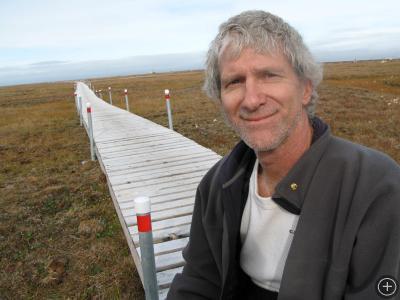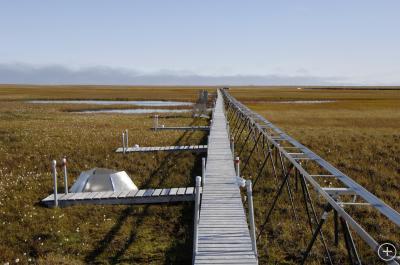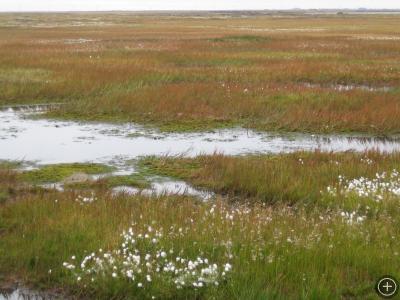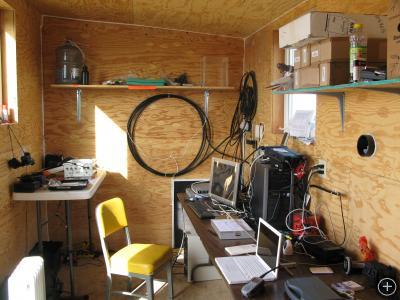
Understanding the tundra’s role in regulating greenhouse gases and global climate change
Performing controlled scientific experiments in a living ecosystem is complex and very difficult, but important to understanding how biological communities will respond to and affect climate change. This is an especially critical research question in the high Arctic, where global warming is happening at twice the rate of more temperate regions of the earth.
Steve Hastings and his colleagues (Principal Investigators Drs. Oechel, Tweedie, Oberbauer, and Gamon) are looking at how soil moisture, expected to change with a changing climate, might in turn affect the release or retention of greenhouse gases such as carbon dioxide and methane.
The interdisciplinary team’s large-scale project will manipulate the water moisture in soil within different sections of a small, shallow lake that is less than 1 foot deep (30 cm), 1,000 yards x 300 yards (915 m x 27 m). Lakes such as this dot the landscape on the North Slope of the Alaskan Arctic, making up 50–75 percent of the aerial coverage. In the experiment, each section of the lake will be separated by a plastic sheet that will act as a dam. One portion of the lake will serve as an experimental control while another will be flooded so that the water table is adjusted a foot above that of the control. Another section will be drained so that the water table is a foot below the control. Comparing these three regions will help Steve and his colleagues understand how soil moisture affects the release of greenhouse gases.
While climate models presage a wetter, warmer atmosphere, higher temperatures in the Arctic could result in more evaporation and drier soils. Drier conditions are predicted to result in more carbon dioxide release but less methane emissions. Wetter soil conditions would likely result in more methane release but less carbon dioxide release. The balance between these two greenhouse gases is important to know because methane is 20 times more efficient at trapping warmth than carbon dioxide.
The long-term goals of the project are to quantify the type and amount of greenhouse gases that would be released in either a wetter or drier Arctic climate. But there may be other climate change impacts on the tundra. As temperature and moisture fluctuates, plant biomass (the amount of green matter) as well as plant types could also change. As soil moisture changes, the nutrients available to plants will also likely change, but scientists don’t yet know how nutrient balance will be affected. All of these factors (soil nutrients, plant type, and plant biomass) will be affected by changes in soil moisture and can ultimately modify the amount and types of greenhouse gases released by the tundra. This could tip the climate balance not just in the Arctic, but throughout the world. With almost 20 percent of the world’s soil organic carbon stored (for now) in the frozen layers of the Arctic called permafrost, a changing climate has the potential to intensify the atmospheric rise in greenhouse gases and contribute to global warming. Conversely, with changes in plant type, and possibly more nutrients, plants could grow bigger and help soak up greater quantities of atmospheric carbon dioxide. Plant physiologists, hydrologists, geographers, microbiologists, and climate modelers are working together to collect and interpret this large-scale manipulation experiment designed to give us insight into the future climate on earth.
















